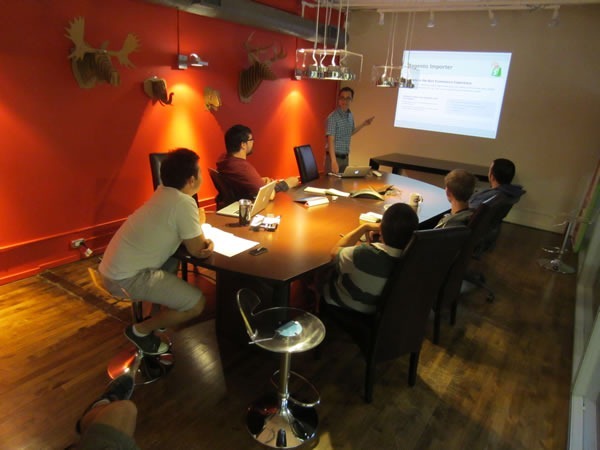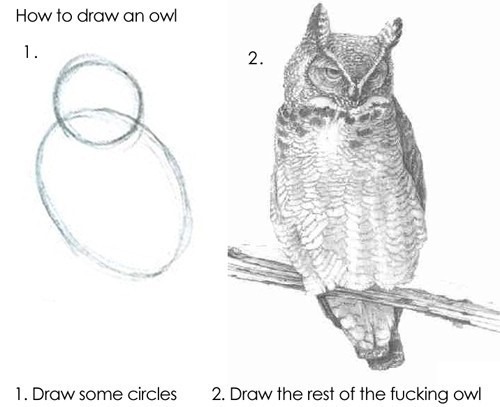
Pictured above is the team at Shopify to which I belong. It’s the Apps Team, and while it may be small, it takes on the company’s most ambitious projects: theShopify App Store, Shopify Experts, Shopify Partners and Shopify Fund as well as the company’s business development and developer advocacy efforts. It’s our team’s job to take the Shopify platform and see how far we can take it.
As a small team charged with a lot of responsibilities, we have to do things in a way that maximize the effect our actions have. Over the past year, we’ve worked out a number of ways of doing this, some gained from experience, others from experimentation. They’ve remained what’s called "tacit knowledge" — practiced by the team but not written down or formally codified in an operations manual — until team leader Harley Finkelstein, our Chief Platform Officer, collected them into a set of slides.
The way we get things done boils down to the general principles listed below. Your team may not be like ours, but I’m sharing these principles because you might find at least some of them useful:
- Act like an owner. You don’t "just work here", you own a piece of a company and have a stake in its success. Work as if your livelihood, career and reputation were riding on it, because as an owner, it is! Be entrepreneurial and own your domain: if you have an idea and it lines up with the company’s goals, make that idea happen.
- Know what to work on and what things to ship. While owners have the freedom to work on and ship whatever they like, they also work in the real world. 80% of what makes the company go is often achieved by doing the most important work first, which typically makes up 20% of the available tasks. Sometimes these tasks can be tedious and feel like drudgery, but if they’re what makes things happen for our customers and their customers, they’ve got to be done, and with the highest priority.
- Done is better than perfect, or "the best" is the enemy of "the good". Perfectionism is a form of procrastination. It assumes that time is an infinite resource, that other tasks can wait while you add "just one more touch" and that "perfect" is attainable. You have to be able to make the call and say "done" at some point. A good feature that our customers use and enjoy is infinitely better than a perfect one that "will be available soon". As they say at Apple, "Real artists ship".
- Have high standards. While done is better than perfect, good still remains better than bad.
- It’s okay to fail; just fail gracefully. The only sure-fire way to not fail is to not do anything. Since we can’t do that and remain in business, never mind take the company to the heights we want to, we have to accept failure as part and parcel of trying. Sometimes we’ll make mistakes, other times we’ll do things right and still our best-laid plans won’t work because of circumstances outside our control. The trick is to learn from failure and make sure our failures aren’t fatal. As our CEO Tobi likes to say: "If I’m not failing every now and again, I’m not trying hard enough."
- Communicate good news quickly, communicate bad news ever more so. The first part is easy: it takes no effort to tell the team your project is a success. It’s a good thing to do so; good news bolsters the team and success often breeds more success. However, a combination of pride and fear (and in some companies, a "cover your ass" culture) makes it difficult to tell the team that you’re having trouble or that something’s not working out. It’s best to tackle problems as soon as possible, while they’re still small and manageable, and the best way to do this is to communicate bad news as quickly as possible — remember, it’s okay to fail.
- Understand and respect the makers’ and managers’ schedules. As Paul Graham wrote in his essay, Maker’s Schedule, Manager’s Schedule, makers and managers operate by different schedules. Managers’ days are determined by their appointment calendars, which divide the days into hours and even half-hours, and things like meetings fit into the manager’s schedule easily. Makers, on the other hand, do things in half-day or even full-days blocks, and things like meetings are disruptive. Some of the team operate on a maker’s schedule, other operate on a manager’s schedule, and many of us switch between the two, depending on what day it is and what tasks they have on that day. Know who operates on which schedule (and when), and understand and respect those schedules.
- Operate lean and mean. We’re made up of multi-talented, capable, autonomous, ambitious go-getters, and that means we don’t have to operate like a big, lumbering beast. Unless the circumstances are unusual, there really should be 2 people maximum per deal or project. Meetings and calls should be kept to 30 minutes or less, not counting brainstorming or design pow-wows. And full-on meetings aren’t always necessary: you should be able to "just pop by" anyone’s office or desk or call them up on Skype.
- Update often. Because we operate lean, means and independently, communication is vital. Keep your teammates apprised of your progress!
- Draw the owl. In the end, that’s what you’re trying to do…

5 replies on “How Shopify’s Apps Team Gets Things Done”
I am a bit blushed to say so, but I needed to read this today. So helpful! Thanks, Joey, for the excellent write-up.
Love this article! I love that someone actually felt compelled to write it down. I plan to share this and hope it becomes the credo as other teams become lean and mean in the organization!
Thanks!
[…] How Shopify’s Apps Team Gets Things Done — Global Nerdy. jQuery(document).ready(function($) { window.setTimeout('loadGoogle1_85()',1000);window.setTimeout('loadTwitter_85()',1000); }); function loadGoogle1_85(){ jQuery(document).ready(function($) { $('.dd-google1-85').remove();$.getScript('https://apis.google.com/js/plusone.js'); }); } function loadTwitter_85(){ jQuery(document).ready(function($) { $('.dd-twitter-85').remove();$.getScript('http://platform.twitter.com/widgets.js'); }); } Posted by admin at 15:36 Tagged with: draw, owl […]
Many of these are tacit knowledge here too, having them pulled together in this post is fantastic. Nice job and thanks!
[…] I recently wrote about how my team (and pretty much every other team at Shopify) gets things done, but it’s worth repeating: […]